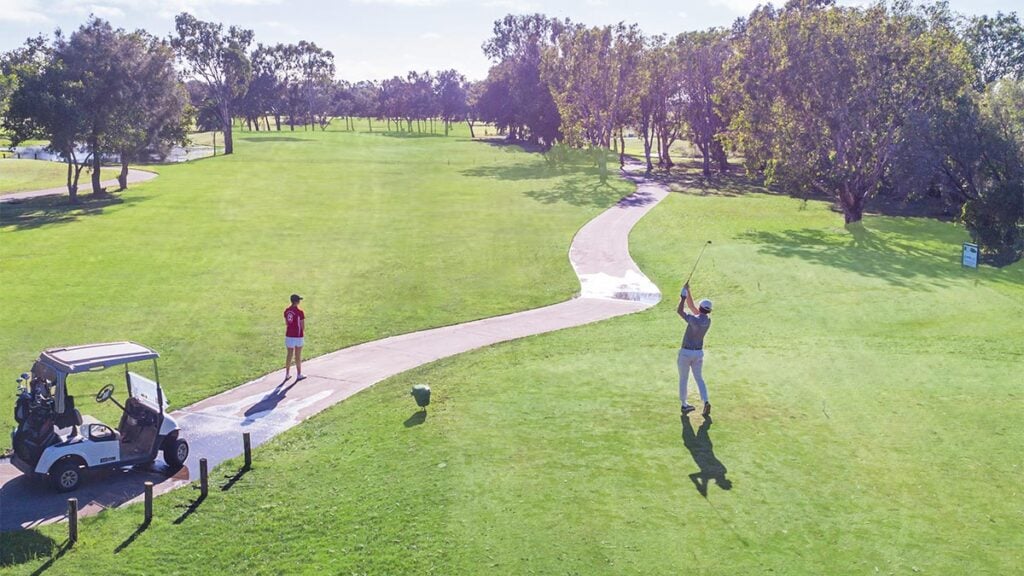Rory McIlroy’s completion of the career Grand Slam leaves us pondering: who’s next?
June means the heart of the majors season in golf, which is a nice place to be in the game’s calendar even if the weather in many parts of Australia is now less agreeable.
The altered cadence of the men’s majors since the PGA Championship moved from August to May places heightened importance on the roughly 100-day period each year that envelopes the Masters in early April to the Open Championship in mid-July. There’s a case to be made that it’s too condensed a stretch of time to play all four majors. Likewise, the lack of a broader geographic spread of major venues is a discussion I enjoy having with anyone who’ll listen. Yet we’ll save those for another day.
What has my interested piqued for these next couple of months – and possibly next few years – is who will be No.7? After Rory McIlroy became the sixth man to complete the career Grand Slam with his epic Masters victory, the spotlight now turns to those who could join him. The history of men’s golf is littered with names who came close but fell one leg short [see panel], but today there are more contenders than you might think.
In the box seat, technically, is Jordan Spieth, who needs only the PGA Championship to complete the storied set. Some of the venues the PGA of America already had lined up for its major were somewhat unSpieth-like ever since he first had the opportunity to fulfil the quadrilateral in 2017. Like McIlroy, Spieth’s best chance may yet come after a period of patience. Aronimink Golf Club (2026), the untested PGA Frisco (2027) and The Olympic Club (2028) are PGA sites where one could see Spieth prospering – if his game is on.
Of course, the most visible Grand Slam aspirant remains Phil Mickelson. While it’s easy to forget Spieth is just one leg away from the Slam, all golf fans have known Mickelson has been in the same boat since he captured the 2013 Open Championship. His career-long torment with the US Open – the one major he’s missing – is etched in golf lore.
Is the upcoming US Open at Oakmont Country Club Mickelson’s final chance? His exemption into the championship from winning the 2021 PGA at age 50 expires after this edition, and with lacklustre form and still no progress on awarding world-ranking points to LIV Golf tournaments, it’s difficult to see Mickelson even teeing it up at another US Open beyond this year. That makes this month his likely last shot.
Elsewhere are golfers with two legs to go but time on their side. Collin Morikawa (who needs the Masters and US Open), seems to have the best combination of talent, available time, access and major grit. Scottie Scheffler (who needs both Opens) and Xander Schauffele (Masters, US Open) stand right next to Morikawa on those fronts. Brooks Koepka (Masters, Open Championship) unquestionably has the major guile, but time – he’s now 35 – and future exemptions might be his primary hurdles. Jon Rahm (PGA, Open) is in a similar way, but at 30 has five more years up his sleeve. Turning 41 in June, Dustin Johnson (PGA, Open) might have missed his window, likewise for Martin Kaymer (Masters, Open), Zach Johnson (PGA, US Open), Ernie Els (Masters, PGA), Vijay Singh (US Open, Open), Padraig Harrington (Masters, US Open) and Angel Cabrera (PGA, Open).
This ‘missing leg’ angle has been part of the narrative at majors for several years, as each American major has had one player on the doorstep of the career Grand Slam (until McIlroy walked through that door). Whether a seventh golfer can join our sport’s most elite club will be fascinating to watch.
Top 5 golfers without the Grand Slam
5. Lee Trevino: Lacking only the Masters, Trevino never could solve the riddle of Augusta National. In 20 tries, he didn’t fare better than 10th place.
4. Arnold Palmer: Palmer won all seven of his majors in a six-year span, the last at age 35. That gave him 33 chances to snare the PGA Championship and complete the Slam, yet he couldn’t surpass three runner-up results.
3. Tom Watson: Like Palmer, the PGA was the lone major to elude Watson. His best chance came in 1978 when he led by five shots beginning the last day, only to lose in a playoff.
2. Walter Hagen: The 11-time major winner perhaps deserves top spot here, yet he was denied more chances to close out the Grand Slam by timing, as the Masters was only in its infancy during his career (he played in just four, withdrawing from two more).
1. Sam Snead: In an eerie precursor to Phil Mickelson’s experiences, Snead [above] simply couldn’t get over the line in his national championship, losing the US Open every which way amid four runner-up finishes.
Main Photo: bettmann/getty images



